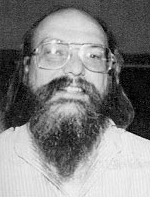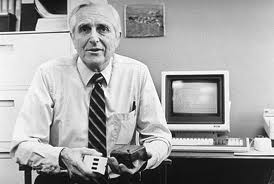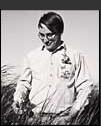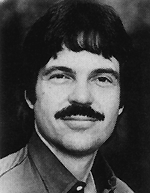While I am working away programming this site, gathering information and
technics (I am stunned), I really have to mention some contributor ...
who helped, supported and realized this site, my fun and much, much more ...
therefore I hereby say "thank you" to:
 Dennis Ritchie died alone and nearly forgotten October 12, 2011 (one week after Steven Jobs) ... you
might wonder now why I am mentioning him here (besides that he is a true hero of mine) ... what if I
told you that his "brain child" rules probably 99.9% of everything that has a Microprocessor
(mobilephones, washmachines, computers, the lot) ... Dennies Richie is the creator of the C programming
language (a real engineers delight). The C language philosophy (concepts and principles) can be found in
all modern programming languages and operating systems (Windows, Linux, Android and Mac OSX/iOS).
Dennis Ritchie died alone and nearly forgotten October 12, 2011 (one week after Steven Jobs) ... you
might wonder now why I am mentioning him here (besides that he is a true hero of mine) ... what if I
told you that his "brain child" rules probably 99.9% of everything that has a Microprocessor
(mobilephones, washmachines, computers, the lot) ... Dennies Richie is the creator of the C programming
language (a real engineers delight). The C language philosophy (concepts and principles) can be found in
all modern programming languages and operating systems (Windows, Linux, Android and Mac OSX/iOS).
 Ken Thompson ... maybe even less obvious than Dennis Ritchie, Thompson has to be mentioned here. Thompson is
the main creators and early developer of the Unix operating systems ... and again, as said above, Unix's
philosophy (concepts and principles) also can be found almost all modern operating systems (Windows, Linux,
Android and Mac OSX/iOS) ... The Unix operating system, developed in 1969 at Bell Labs, was first
written in assembly language, but had been later (1973) almost entirely recoded in C.
Ken Thompson ... maybe even less obvious than Dennis Ritchie, Thompson has to be mentioned here. Thompson is
the main creators and early developer of the Unix operating systems ... and again, as said above, Unix's
philosophy (concepts and principles) also can be found almost all modern operating systems (Windows, Linux,
Android and Mac OSX/iOS) ... The Unix operating system, developed in 1969 at Bell Labs, was first
written in assembly language, but had been later (1973) almost entirely recoded in C.
The early developer group at AT&T (Bell Labs): Ken Thompson, Dennis Ritchie, Brian Kernighan,
Douglas McIlroy, and Joe Ossanna.
 Douglas Engelbart (ever heard of him) and his research team (some of whom worked later, 1976, for Xerox PARC).
Douglas Engelbart outlined, as early as 1968, in a presentation which is known today as "The Mother of all Demos"
how computing could/should/would be in the 21th century ... "the live demonstration featured the introduction
of the computer mouse, video conferencing, teleconferencing, hypertext, word processing, hypermedia, object
addressing and dynamic file linking, bootstrapping, and a collaborative real-time editor" (Wikipedia) ... wow,
there is a real eyeopener: "Steven Jobs did definitely not invent the Graphical User Interface".
Douglas Engelbart (ever heard of him) and his research team (some of whom worked later, 1976, for Xerox PARC).
Douglas Engelbart outlined, as early as 1968, in a presentation which is known today as "The Mother of all Demos"
how computing could/should/would be in the 21th century ... "the live demonstration featured the introduction
of the computer mouse, video conferencing, teleconferencing, hypertext, word processing, hypermedia, object
addressing and dynamic file linking, bootstrapping, and a collaborative real-time editor" (Wikipedia) ... wow,
there is a real eyeopener: "Steven Jobs did definitely not invent the Graphical User Interface".
 Tim Berners Lee, who is single-handedly responsible for inventing the World Wide Web.
He also wrote the first World Wide Web server, "httpd", and the first client, "WorldWideWeb"
a what-you-see-is-what-you-get hypertext browser/editor which ran in the NeXTStep environment.
Tim now holds the 3Com Founders chair at the Laboratory for Computer Science (LCS) at the
Massachusetts Institute of Technology (MIT). He also directs the World Wide Web Consortium,
an open forum of companies and organizations with the mission to lead the Web to its full
potential ...
Tim Berners Lee, who is single-handedly responsible for inventing the World Wide Web.
He also wrote the first World Wide Web server, "httpd", and the first client, "WorldWideWeb"
a what-you-see-is-what-you-get hypertext browser/editor which ran in the NeXTStep environment.
Tim now holds the 3Com Founders chair at the Laboratory for Computer Science (LCS) at the
Massachusetts Institute of Technology (MIT). He also directs the World Wide Web Consortium,
an open forum of companies and organizations with the mission to lead the Web to its full
potential ...
http://www.w3.org/People/Berners-Lee/
 October 5, 1991 05:41:06 GMT: The young student Linus Torvalds from Finland releases Linux
version 0.02 which is the first official release. Linux is a UNIX like OS based on POSIX
which is distributed with free source code.
October 5, 1991 05:41:06 GMT: The young student Linus Torvalds from Finland releases Linux
version 0.02 which is the first official release. Linux is a UNIX like OS based on POSIX
which is distributed with free source code.
 Linus Torvalds wrote in the announcement: "I've enjoyed doing it, and somebody might enjoy
looking at it and even modifying it for their own needs" (The understatement of the decade).
Linus Torvalds wrote in the announcement: "I've enjoyed doing it, and somebody might enjoy
looking at it and even modifying it for their own needs" (The understatement of the decade).
 Richard Matthew Stallman (RMS; born March 16, 1953) is a central figure of the free software
movement, founder of the GNU project and the Free Software Foundation. He invented the concept
of copyleft to support this movement, and embodied the concept in the widely-used GNU General
Public License (GPL) software license. He is also a notable programmer with his major accomplishments
including the text-editor Emacs, the compiler GCC, and the debugger GDB, all of which are part
of the GNU project
Richard Matthew Stallman (RMS; born March 16, 1953) is a central figure of the free software
movement, founder of the GNU project and the Free Software Foundation. He invented the concept
of copyleft to support this movement, and embodied the concept in the widely-used GNU General
Public License (GPL) software license. He is also a notable programmer with his major accomplishments
including the text-editor Emacs, the compiler GCC, and the debugger GDB, all of which are part
of the GNU project
 Ed Roberts, there is no doubt, is the Father of the Personal Computer. It is generally accepted
that his MITS-Altair, circa 1975, was the first mass produced, commercially successful personal
computer, and Ed Roberts, with some help, masterminded its creation and success.
Ed Roberts, there is no doubt, is the Father of the Personal Computer. It is generally accepted
that his MITS-Altair, circa 1975, was the first mass produced, commercially successful personal
computer, and Ed Roberts, with some help, masterminded its creation and success.
It's hard to argue about the importance of Ed Roberts and the MITS-Altair that has set the
stage for Apple and the rest. Roberts is also the man who hired Bill Gates and Paul Allen,
and pioneered many facets of the industry.
http://www.fireinthevalley.com/fitv_book5.html
 Sometime in late 1971,
a computer engineer named Ray Tomlinson sent the first e-mail message. "I sent a number
of test messages to myself from one machine to the other," he recalls now. "The test
messages were entirely forgettable. . . . Most likely the first message was QWERTYIOP
or something similar."
Ray Tomlinson's name hardly lives in the public mind. When he is remembered at all, it is
as the man who picked @ as the locator symbol in electronic addresses. In truth though,
he is the inventor of e-mail, the application that launched the digital information
revolution. And yet the breakthrough he made was such a simple revolutionary step that
hardly anyone noticed it till later. At the time, it barely registered with Ray Tomlinson
Sometime in late 1971,
a computer engineer named Ray Tomlinson sent the first e-mail message. "I sent a number
of test messages to myself from one machine to the other," he recalls now. "The test
messages were entirely forgettable. . . . Most likely the first message was QWERTYIOP
or something similar."
Ray Tomlinson's name hardly lives in the public mind. When he is remembered at all, it is
as the man who picked @ as the locator symbol in electronic addresses. In truth though,
he is the inventor of e-mail, the application that launched the digital information
revolution. And yet the breakthrough he made was such a simple revolutionary step that
hardly anyone noticed it till later. At the time, it barely registered with Ray Tomlinson
 Alan Kay in 1971, inventor
of Smalltalk which was the inspiration and technical basis for the MacIntosh and subsequent
windowing based systems (NextStep, Microsoft Windows 3.1/95/98/NT, X-Windows, Motif, etc.)
Alan Kay in 1971, inventor
of Smalltalk which was the inspiration and technical basis for the MacIntosh and subsequent
windowing based systems (NextStep, Microsoft Windows 3.1/95/98/NT, X-Windows, Motif, etc.)
http://www.smalltalk.org/alankay.html
 VisiOn ... The very first GUI for the IBM PC (in 1982). A graphical environment promoted by VisiCorp, the
publishers of the VisiCalc spreadsheet ... Bill Gates sits through three back-to-back demonstrations.
He flies in other Microsoft officials to watch, then hightails it back to Washington to
work on plans for his own graphical overlay for DOS. Well done Bill, you've got that just right.
VisiOn ... The very first GUI for the IBM PC (in 1982). A graphical environment promoted by VisiCorp, the
publishers of the VisiCalc spreadsheet ... Bill Gates sits through three back-to-back demonstrations.
He flies in other Microsoft officials to watch, then hightails it back to Washington to
work on plans for his own graphical overlay for DOS. Well done Bill, you've got that just right.
http://members.fortunecity.com/pcmuseum/vision.htm
 Having mentioned early software developments ... I have to talk about VisiCalc, Daniel
Bricklin and Bob Frankston the programmer of it too. When we look back we recognize that
VisiCalc was the first "killer" application for personal computers. It has changed computers
from a hobby toy to be a business tool. The name "VisiCalc" is a compressed form of the phrase
"visible calculator". VisiCalc was the first computer spreadsheet program. VisiCalc became an
almost instant success and provided many business people with an incentive to purchase a personal
computer. It was released to the public in 1979, running on an Apple II computer.
Having mentioned early software developments ... I have to talk about VisiCalc, Daniel
Bricklin and Bob Frankston the programmer of it too. When we look back we recognize that
VisiCalc was the first "killer" application for personal computers. It has changed computers
from a hobby toy to be a business tool. The name "VisiCalc" is a compressed form of the phrase
"visible calculator". VisiCalc was the first computer spreadsheet program. VisiCalc became an
almost instant success and provided many business people with an incentive to purchase a personal
computer. It was released to the public in 1979, running on an Apple II computer.
http://www.bricklin.com/history/saiproduct1.htm
 To get a feel for what
VisiCalc was like to use, you can try a copy of the early IBM PC VisiCalc from 2 years later
in 1981. It still runs on today's PCs under MSDOS in Windows. That version of VisiCalc was
only 27K bytes in size.
To get a feel for what
VisiCalc was like to use, you can try a copy of the early IBM PC VisiCalc from 2 years later
in 1981. It still runs on today's PCs under MSDOS in Windows. That version of VisiCalc was
only 27K bytes in size.
 And (!!!) not to be forgotten ... the people of the Xerox Palo Alto Research Center (PARC),
1970-1984 who "brain-stormed" the ideas of Douglas Engelbart and build all the crazy and till then unthinkable
futuristic computer gear we use today ... GUI-Operating Systems, Mouse, first laser printer,
Ethernet network Systems etc. etc. ...
And (!!!) not to be forgotten ... the people of the Xerox Palo Alto Research Center (PARC),
1970-1984 who "brain-stormed" the ideas of Douglas Engelbart and build all the crazy and till then unthinkable
futuristic computer gear we use today ... GUI-Operating Systems, Mouse, first laser printer,
Ethernet network Systems etc. etc. ...
http://www.parc.xerox.com/history.html
 Subsequently, I should probably say thanks to people like Steve Jobs and his fellow men at Apple Computer
and "NeXTStep" for their visionary approach to marked all the above ideas as a new and independent enterprise ...
computing as we know it today.
Subsequently, I should probably say thanks to people like Steve Jobs and his fellow men at Apple Computer
and "NeXTStep" for their visionary approach to marked all the above ideas as a new and independent enterprise ...
computing as we know it today.
http://www.osdata.com/oses/next.htm
http://www.mackido.com/History/AppleTimeline.html
... and yes Microsoft for not muck-up the whole "thing" entirely (at least until now) and share the "spoils" with the rest of us not Apple diciples ...
http://www.darwinsys.com/history/mslies.html#ripoff
Alan Chavis (of FTPx Corp) for his great and free FTP Explorer, who helped me to upLoad and maintain this site ...
http://www.ftpx.com
Stefan Münz, who has created SelfHTML a fantastic free online documentation about HTML ...
Superb information, superb design (lovely) ... unfortunately only in German (the whole world would really love it) ...
http://www.teamone.de/selfaktuell/
Brian Postma, for his nice Pac Man Game I use in Erwin's Section and the Pong Game
I use in Gaby's Section ...
http://www.homepages.hetnet.nl/~brianpostma/
Mike Hall, for his super java script adaption of Asteroids, I use in Linus's Section and
Word Search I use in the Farm Section.
Omar Wally, for his Snake Game ... I use in Anja's Section.
surfsup_79@hotmail.com
Fabio Ciucci and his Anfy Team who has created the most stunning Java-Web effect
I've ever seen (Cube menu/Raindrop effects on pictures etc.) ...
http://www.anfyteam.com/panjava.html ...
And all the great sites with tones of help and free scripts ...
I really can only mention some:
http://www.brainjar.com/
http://www.freewarejava.com/
http://www.a1javascripts.com/
http://www.pagetutor.com/jsdocs/toc.html
http://www.jsexamples.com/examples/files/
http://javaboutique.internet.com/stats/archive.html
etc. etc. etc.
The unknown artist who has created the lovely MIDI-Soundtrack of the Cube-Menu "Plunkett.mid"
A Song which was composed as a harp piece by the 18th century harper Turlough O Carolan.
Written in praise of one Eleanor Plunkett of Robertstown, County Meath, who, it seems,
was just one of the 30 members of the Plunkett family. The story has it that they were
locked, or locked themselves, into their castle at Castlecome, two miles from Robertstown.
Then they were killed with boiling water. Learned from the book "The Life, Times and Music
Of An Irish Harper", by Donall O Suilleabain.
Huch, and "last but not least", my mum and dad who always believed in me and helped me
to find my own way and to be able to do stuff, like this ... also my lawyer
and all the teachers and my nanny ... and my children, who didn't distract me too much, after all.
(I am just kidding).
 Dennis Ritchie died alone and nearly forgotten October 12, 2011 (one week after Steven Jobs) ... you
might wonder now why I am mentioning him here (besides that he is a true hero of mine) ... what if I
told you that his "brain child" rules probably 99.9% of everything that has a Microprocessor
(mobilephones, washmachines, computers, the lot) ... Dennies Richie is the creator of the C programming
language (a real engineers delight). The C language philosophy (concepts and principles) can be found in
all modern programming languages and operating systems (Windows, Linux, Android and Mac OSX/iOS).
Dennis Ritchie died alone and nearly forgotten October 12, 2011 (one week after Steven Jobs) ... you
might wonder now why I am mentioning him here (besides that he is a true hero of mine) ... what if I
told you that his "brain child" rules probably 99.9% of everything that has a Microprocessor
(mobilephones, washmachines, computers, the lot) ... Dennies Richie is the creator of the C programming
language (a real engineers delight). The C language philosophy (concepts and principles) can be found in
all modern programming languages and operating systems (Windows, Linux, Android and Mac OSX/iOS).
 Ken Thompson ... maybe even less obvious than Dennis Ritchie, Thompson has to be mentioned here. Thompson is
the main creators and early developer of the Unix operating systems ... and again, as said above, Unix's
philosophy (concepts and principles) also can be found almost all modern operating systems (Windows, Linux,
Android and Mac OSX/iOS) ... The Unix operating system, developed in 1969 at Bell Labs, was first
written in assembly language, but had been later (1973) almost entirely recoded in C.
Ken Thompson ... maybe even less obvious than Dennis Ritchie, Thompson has to be mentioned here. Thompson is
the main creators and early developer of the Unix operating systems ... and again, as said above, Unix's
philosophy (concepts and principles) also can be found almost all modern operating systems (Windows, Linux,
Android and Mac OSX/iOS) ... The Unix operating system, developed in 1969 at Bell Labs, was first
written in assembly language, but had been later (1973) almost entirely recoded in C.  Douglas Engelbart (ever heard of him) and his research team (some of whom worked later, 1976, for Xerox PARC).
Douglas Engelbart outlined, as early as 1968, in a presentation which is known today as "The Mother of all Demos"
how computing could/should/would be in the 21th century ... "the live demonstration featured the introduction
of the computer mouse, video conferencing, teleconferencing, hypertext, word processing, hypermedia, object
addressing and dynamic file linking, bootstrapping, and a collaborative real-time editor" (Wikipedia) ... wow,
there is a real eyeopener: "Steven Jobs did definitely not invent the Graphical User Interface".
Douglas Engelbart (ever heard of him) and his research team (some of whom worked later, 1976, for Xerox PARC).
Douglas Engelbart outlined, as early as 1968, in a presentation which is known today as "The Mother of all Demos"
how computing could/should/would be in the 21th century ... "the live demonstration featured the introduction
of the computer mouse, video conferencing, teleconferencing, hypertext, word processing, hypermedia, object
addressing and dynamic file linking, bootstrapping, and a collaborative real-time editor" (Wikipedia) ... wow,
there is a real eyeopener: "Steven Jobs did definitely not invent the Graphical User Interface".